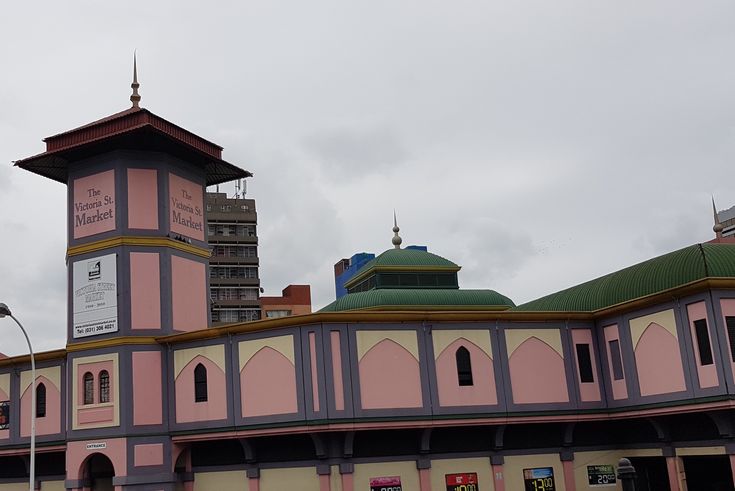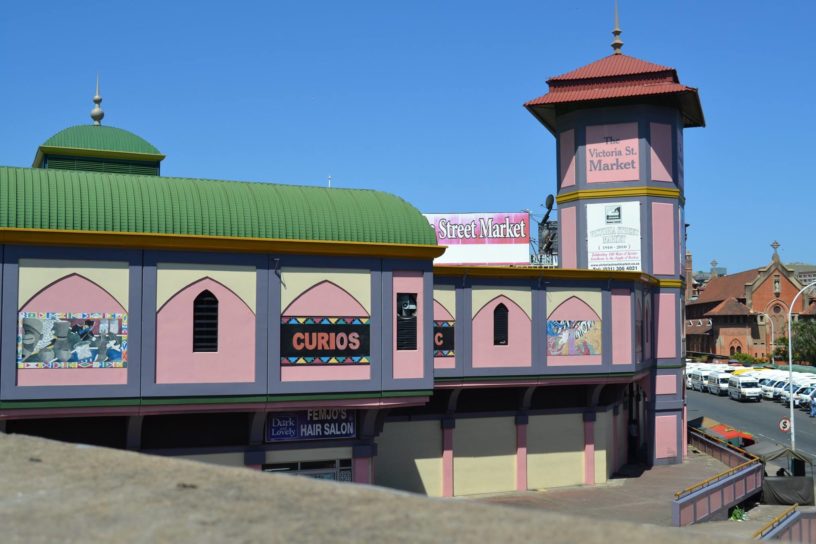
Victoria Street Market, Durban photo by Victoria Street Market Facebook Page.
Top 10 Interesting Facts about Victoria Street Market, Durban.
The Victorian Street Market is an exquisite market that covers over 6000 square feet. It is a huge building that is located close to some of the best accommodations in Durban.
It is located on the corner of Queen and Victorian streets. It offers a grand variety of products for visitors to choose from encompassing a unique blend of all things Indian and African.
There are more than 170 stalls offering the freshest and best quality of products displaying their wares from food, spices, and incense that rent the air upon entry.
The market known as The Vic by the locals is an ornate structure humming with lively vendors with delights of colorful varieties that come by the barrel and a fish market. Here are 10 interesting facts about the Victorian street market:

Victoria Street Market Durban-Wikimedia Commons.
1. They showcase the Indian Culture in Durban which is the Largest Outside of Asia
The showcase was first opened in the 1870s that has had a huge impact on the city of Durban since.
The showcase which demonstrates the largest Indian community in Africa and the world outside of Asia offers a fantastic way for the people to learn and indulge in the culture and heritage.
The open-air market that evolved into the Victoria street market offers a fantastic way for individuals to familiarize themselves with food, clothes, perfumes, etc.
The bold colors, vibrant smells, and bartering are some of the features people encounter that are characteristic of the nature of the community.
The visitor also gets to purchase custom-made goods like saris, beaded dolls, animals, oriental ceramics, etc.

Victoria Street Market, Durban photo by Unknown-Pinterest.
2. It is One of the Oldest Markets in Durban
The Victoria market was once known as the Indian Market due to the original traders who settled in the area around the period of 1860- 1910.
The Indian traders were the original indentured laborers who traded along the street.
In 1910 the municipal of Durban legalized and located the area specifically for the traders and established the market to house these traders that coincidentally are in use till date with other changes.
The Victoria Street market came into place at the beginning of the 1980s replacing the Indian market after it was destroyed by fire in 1973.

Victoria Street Market, Durban photo by unknown-Pinterest
3. There is Old Indian Architecture Still in Place
The Victoria Market was once an Indian market filled with merchants and vendors. The traders built a vast series of shops and houses to cater to their needs.
Sadly, most of the market was destroyed after the fire in 1973 but was rebuilt when the street Market was revived.
The distinctive Indian Architecture which is the cultural heart of the community is still in place showcased by the colonnades over pavements, narrow lanes, and a wave of material shops.
This is all located in a street around the market called Dr. Yusuf Dadoo street which was once known as Grey Street. Here the old reputation of Grey streets former status as a clothing mecca still lingers.

Victoria Street Market, Durban photo by Bgabel-Wikimedia Commons.
4. The Market was First Built at a Time of Controversy.
The initial establishers of the market were Indian laborers. They arrived in South Africa in 1860 and were approximately 152, 641 people to work in the sugar cane fields.
They worked under a five-year contract upon expiry 60% of them decided to make South Africa a permanent residency.
The remaining population was split into two groups, those who renewed their indenture in the Natal colony and those who returned to India.
The majority began to trade along the street to make a living. This venture was often met with conflict as the traders struggled to fight racial and restrictive authority.
5. The Market was once Regarded as a Squatters’ Market
The Indian Traders were often met with opposition from the council and the white people.
Various restrictions were implemented to eradicate the traders one of which was a ruling that decreed the trading was to cease at 09:00 on the weekdays and 10:30 on Saturdays.
The traders were required to clear the area or be subjected to the water cart. The municipal water cart was launched into the street to wash down any waste or chase away vendors from the market violating the rules.
This would then force the traders to squat cross-legged in the street alongside their goods which is how they got the name squatters.
This in turn helped Grey street as this was where most traders would relocate to develop into an established business district.
Grey street was still met with criticism as the white people called them a nuisance as the streets were covered with rotting leaves and vegetables.
6. The Market was Divided into Two due to Disagreements
As the market continued to grow multiple people funded and established themselves in the trading business.
The market was filled with diverse cultures that were bound to knock heads eventually two of which were the Indians and Muslims.
The enmity between Indians and Muslims dates back to the early 1900s as both cultures have conflicting ideas and conceptions, social customs, and literary traditions.
The schism that developed between the Hindu and Muslim farmers resulted in the division of the market.
The Hindu group organized a market committee to meet with the council to request a separate market for their exclusive use.
The city council then moved the squatter’s market to Warwick Avenue since it was a lucrative establishment for the economy of Natal. The Victoria Street Market then became an outlet for more diversified goods.
7. The Market Lack of Discrimination Led to its Great Success
The Victoria street market once known as the Indian market was established to cater to the needs of the Indian community. It later opened its doors to serve all cultures and racial groups.
This was unlike the other competing markets in Durban like the Borough Market which only served white people.
The white traders of the CBD were discriminative against other races and cultures in terms of their products, place, promotion, and pricing ensuring only whites could access them.
The Street markets ingenuity and opportunistic marketing mix strategy offered customer-centric service allowing for bargains to take place which led to loyal customer return and return on investment.
8. There was an Incredible Fire that Destroyed the First Market
On the 16th of March 1973, there was a huge fire that enveloped the market. The fire that began at 8:45 pm burned the goods and merchandise producing green flames from melting copper flared upwards and fireworks exploded in all directions.
The roof of the building collapsed taking with it two-thirds of the stalls between Cemetery Lane and Queen Street.
Hundreds of people were left desolate facing unemployment and the inability to afford basic needs. The Market was soon after closed officially after the unaffected areas sold all the remaining stock.
In light of this incident, the Mayor of Durban Mr. Ron Williams launched a relief fund on 20th March 1973.
9. The Market has Profound Products and Goods
The street market is not only for the food and spices it offers a wide variety of cultures and heritage goods and merchandise. Visitors get to choose from a wide variety of African and Asian artwork.
The Afro-Indian blend creates a very big exhibit showcasing African carvings, finely crafted Jewelry, brassware, and traditional clothes accompanied by the haunting strains of Indian music mingling with the chatter of stallholders.
It also offers incredibly fresh food lovers delight Seafood & Meat Market.
10. The trader’s Dedication Led to the Growth of the Market
The free Indian traders who settled made a living by gardening, fishing, and selling. The Natal had an accumulated number of 2000 laborers by 1885 working in and around the area.
The Indians established a thriving business by being the cheapest suppliers of fresh produce. These Indians would travel late in the evening arriving around 8 pm and spending the night sleeping under their carts before trading at 4 am the following day.
The market was the trading hub for the Indians selling mainly vegetables in baskets and barrows.
Planning a trip to Paris ? Get ready !
These are Amazon’s best-selling travel products that you may need for coming to Paris.
Bookstore
- The best travel book : Rick Steves – Paris 2023 – Learn more here
- Fodor’s Paris 2024 – Learn more here
Travel Gear
- Venture Pal Lightweight Backpack – Learn more here
- Samsonite Winfield 2 28″ Luggage – Learn more here
- Swig Savvy’s Stainless Steel Insulated Water Bottle – Learn more here
Check Amazon’s best-seller list for the most popular travel accessories. We sometimes read this list just to find out what new travel products people are buying.









